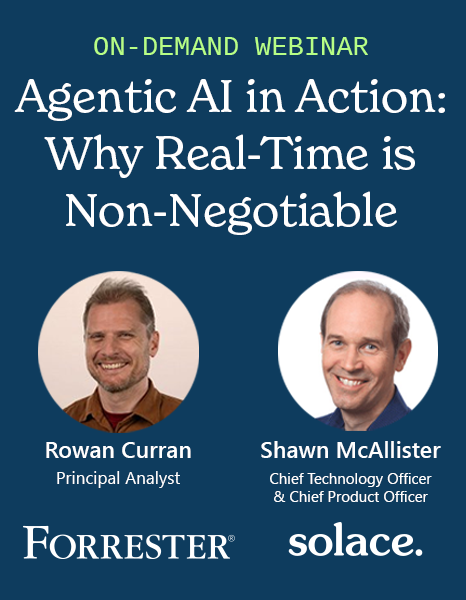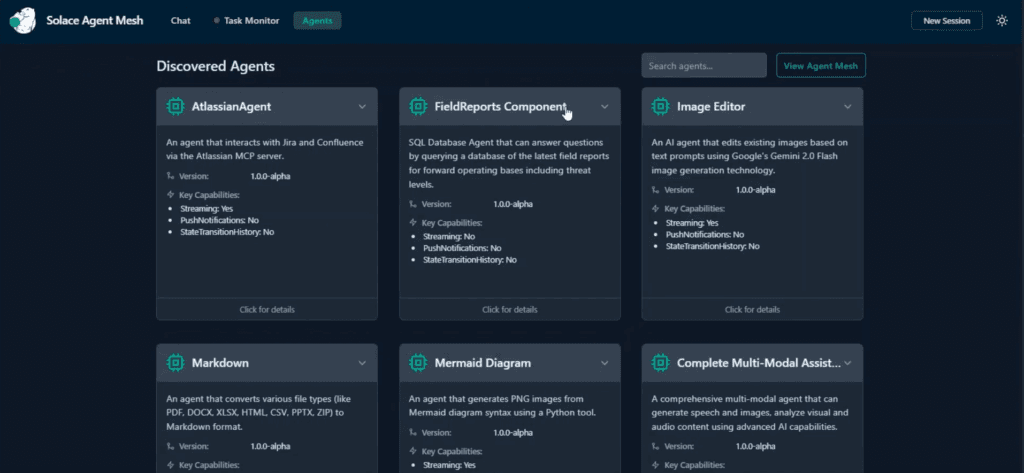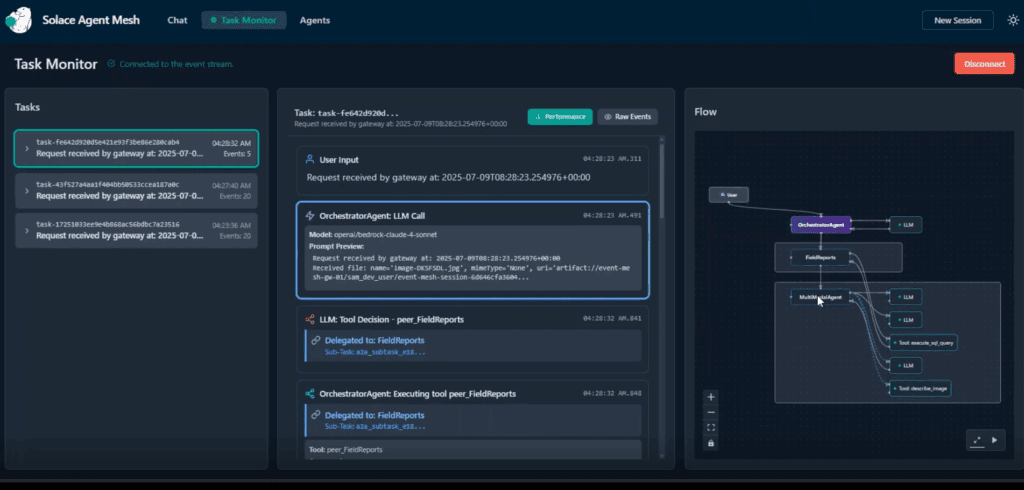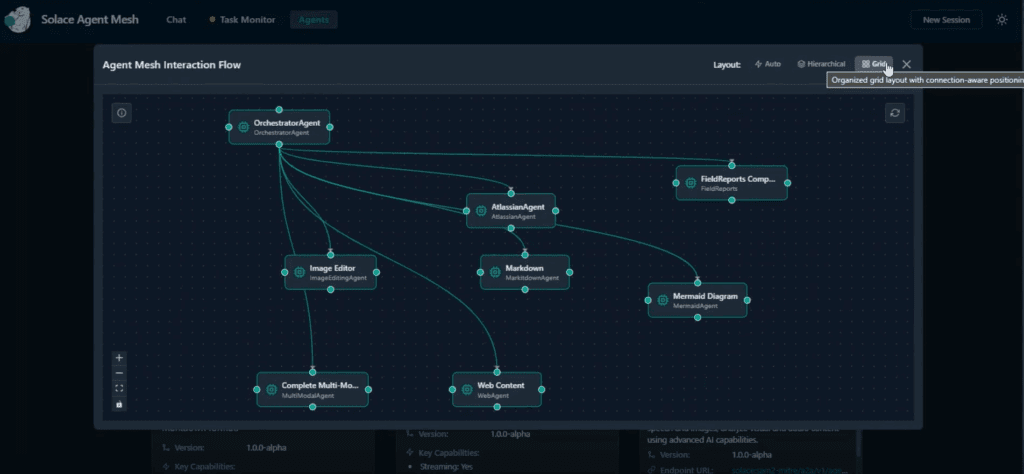Home > Blog > Artificial Intelligence
Subscribe to Our Blog
Get the latest trends, solutions, and insights into the event-driven future every week.
Thanks for subscribing.
In today’s rapidly evolving landscape, command centers in industries such as banking, healthcare, infrastructure, and the military are implementing sophisticated tools to process, analyze, and display critical information in real-time.
One government contractor approached Solace about creating a cutting-edge approach to military situational awareness, leveraging event-driven architecture (EDA), resilient transport mechanisms, and agentic AI to deliver actionable intelligence when it matters most.
This revolutionary system demonstrates how multiple specialized AI agents can work together to analyze information from any source, coordinated through enterprise-grade event-driven infrastructure.
To see the solution in action, check out this video:

The Challenge: Real-Time Situational Awareness
Modern enterprises (and militaries) capture vast amounts of data from diverse sources: field reports, satellite imagery, sensor networks, reconnaissance drones, and human intelligence. It’s remarkably difficult to not just collect this data, but to synthesize it into actionable intelligence that can be consumed quickly by decision makers under pressure.
When threats emerge, every second counts— command personnel need immediate notification of changing conditions, threat escalations, and recommended actions. That means traditional polling-based systems fall short, and the real-time distribution of event-driven architecture becomes not just beneficial, but essential.
The Foundation of Responsive Command Systems
The command solution is built on a robust event-driven architecture that ensures real-time data flow from multiple sources to AI analysis, then distributes the results to multiple command interfaces. At its core, the system is built on Solace Agent Mesh, an agentic AI framework that leverages the event-driven integration capabilities of Solace Platform to transform the way AI supports enterprise command environments.
Event-driven systems excel in scenarios where:
- Latency is critical: Events that contain either intelligence or analysis are pushed immediately when they occur
- Sources are distributed: Multiple systems can publish events independently, no matter where they are located
- Scalability is required New consumers can be added and instantly begin receiving data, without affecting producers
- Reliability is paramount: Built-in redundancy and failover mechanisms
In the command solution, new intelligence is created, including real-time images from forward operating bases or new intelligence reports. Once processed by AI, Agent Mesh generates analysis events to be used by multiple different command centers.
Ensuring Message Delivery
One of the most critical aspects of the system is its resilient transport layer. The command solution is designed to handle data from anywhere – whether it’s a forward operating base with intermittent connectivity, a satellite feed with variable latency, or a secure data center with high-speed connections. With built-in guaranteed message delivery, events are persisted until successfully delivered.
Multi-Source Integration with Agentic AI
The beauty of EDA is its source agnosticism. Analysis data can originate from:
- Field Intelligence Units: Mobile teams reporting real-time observations
- Automated Image Analysis AI agents processing satellite or drone imagery from any source
- Sensor Networks: IoT devices monitoring perimeters and critical infrastructure
- Third-Party Intelligence: Partner organizations sharing threat assessments
- Historical Analysis Systems: Batch processing systems providing context
Each source publishes events to the same messaging infrastructure, but users of the data don’t need to know or care about the origin. This decoupling allows for incredible flexibility in data sources and AI processing pipelines.
Solace Agent Mesh: Agentic AI for Command Intelligence
To understand the command solution, it’s crucial to understand Agent Mesh, an AI framework that powers its intelligence capabilities. Agent Mesh moves beyond single-model AI approaches to orchestrated, collaborative AI ecosystems.
What Makes Agent Mesh Ideal for Command Systems
Unlike traditional AI frameworks that rely on monolithic models, Agent Mesh orchestrates multiple specialized agents, each with distinct capabilities. The power of Agent Mesh lies in its ability to decompose complex analytical tasks into smaller, specialized jobs distributed among multiple agents. For threat analysis, this might involve:
- Image Analysis Agents: Specialized in processing satellite imagery, drone footage, and reconnaissance photos
- Risk Assessment Agents: Focused on threat evaluation and impact analysis
- Communication Agents: Skilled at generating clear, actionable reports and recommendations
- Data Integration Agents: Specialized in accessing and synthesizing information from diverse enterprise sources
This collaborative approach ensures that images and data can come from anywhere—satellite feeds, drone surveillance, ground sensors, partner intelligence—and be processed by the most appropriate specialized agents, regardless of source format or location.
Universal Intelligence Processing
One of the most powerful aspects of Agent Mesh integration is its ability to handle real-time information from multiple sources. The system’s event-driven architecture means that whether information comes from:
- Satellite Constellations: High-resolution imagery from commercial or military satellites
- Drone Networks: Real-time footage from autonomous or piloted UAVs
- Ground Surveillance: Fixed cameras, mobile units, or handheld devices
- Partner Organizations: Intelligence shared from allied forces or agencies
- Historical Archives: Previously captured imagery for pattern analysis
- Social Media Feeds: Open-source intelligence from public platforms
- Chatbot Interfaces: Adhoc queries and information sharing
Agent Mesh can automatically route each information source to the most appropriate specialized agents for analysis. An image analysis agent might identify objects and activities, while a pattern recognition agent correlates findings with historical data, and a geospatial agent determines precise locations and movement patterns. This collaborative processing happens in real-time, with results flowing back through the event mesh to update the command dashboard immediately.
Enterprise-Grade AI Orchestration
Agent Mesh provides enterprise-grade capabilities essential for command environments:
- Two-Tier Security: Fine-grained access control to agents and delegated access to enterprise data
- Horizontal Scaling: Both agents and orchestrators scale independently based on demand
- Resilient Operations: Built-in fault tolerance for unreliable infrastructure
- Real-Time Processing: Event-driven architecture eliminates batch processing delays
- Advanced Data Management: Only necessary data is sent to AI models, reducing costs and improving accuracy
- Geographic Distribution: Deploy agents at multiple different locations, for performance or cost reasons
- Load Balancing: Distribute event processing across multiple brokers
Conclusion: The Power of Event-Driven Agentic AI in Intelligent Command Systems
The future of command and control lies in systems like Solace Agent Mesh that can orchestrate AI collaboration across diverse data sources, process information through specialized agent networks, and present synthesized intelligence in intuitive formats. The command solution shown here represents a significant step toward that future, demonstrating how event-driven collaborative AI can create tools that amplify human decision-making capabilities.
As we continue to face evolving security challenges, systems that combine the reliability of event-driven architecture with the intelligence of collaborative AI will be essential tools in maintaining situational awareness and operational effectiveness.
Agentic AI in Action:Why Real-Time Is Non-NegotiableOn-demand webinar featuring agentic AI case studies and expert analysis from Forrester.Watch the Webinar

Explore other posts from category: Artificial Intelligence

As an architect in Solace’s Office of the CTO, Jesse helps organizations of all kinds design integration systems that take advantage of event-driven architecture and microservices to deliver amazing performance, robustness, and scalability. Prior to his tenure with Solace, Jesse was an independent consultant who helped companies design application infrastructure and middleware systems around IBM products like MQ, WebSphere, DataPower Gateway, Application Connect Enterprise and Transformation Extender.
Jesse holds a BA from Hope College and a masters from the University of Michigan, and has achieved certification with both Boomi and Mulesoft technologies. When he’s not designing the fastest, most robust, most scalable enterprise computing systems in the world, Jesse enjoys playing hockey, skiing and swimming.


Subscribe to Our Blog
Get the latest trends, solutions, and insights into the event-driven future every week.
Thanks for subscribing.



